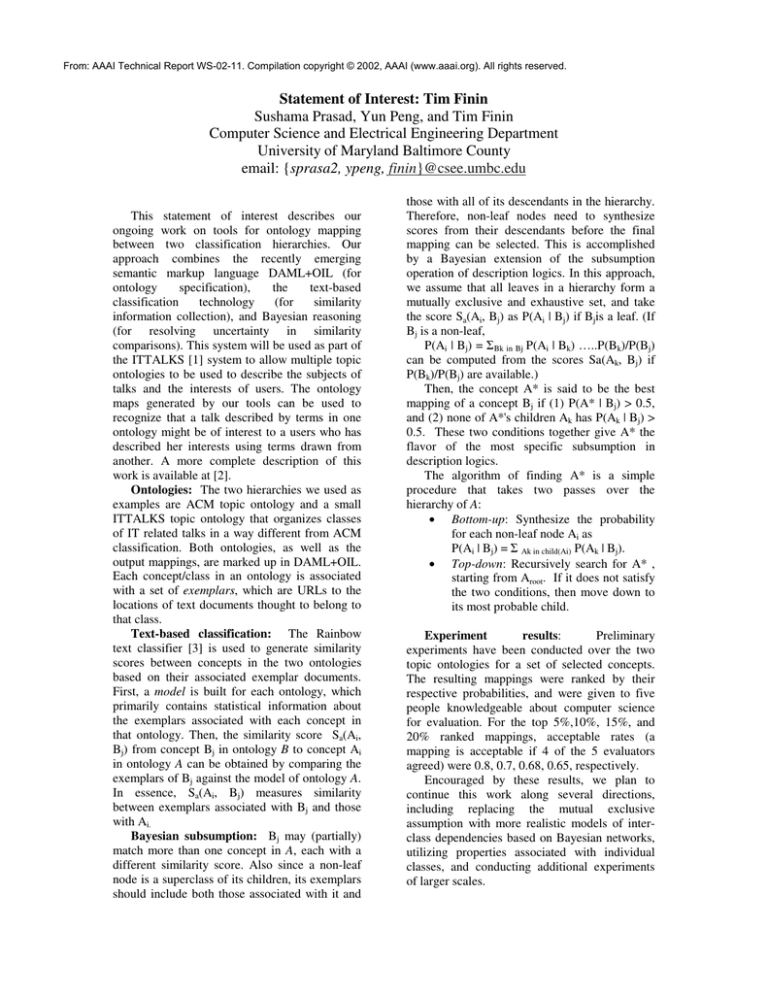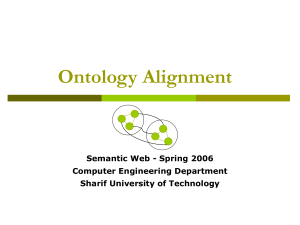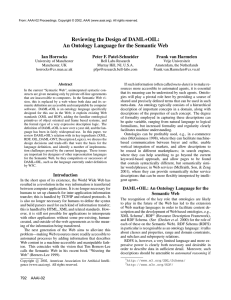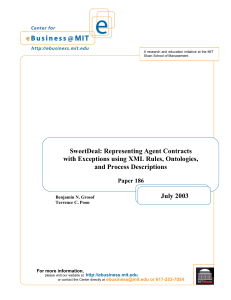
From: AAAI Technical Report WS-02-11. Compilation copyright © 2002, AAAI (www.aaai.org). All rights reserved.
Statement of Interest: Tim Finin
Sushama Prasad, Yun Peng, and Tim Finin
Computer Science and Electrical Engineering Department
University of Maryland Baltimore County
email: {sprasa2, ypeng, finin}@csee.umbc.edu
This statement of interest describes our
ongoing work on tools for ontology mapping
between two classification hierarchies. Our
approach combines the recently emerging
semantic markup language DAML+OIL (for
ontology
specification),
the
text-based
classification
technology
(for
similarity
information collection), and Bayesian reasoning
(for resolving uncertainty in similarity
comparisons). This system will be used as part of
the ITTALKS [1] system to allow multiple topic
ontologies to be used to describe the subjects of
talks and the interests of users. The ontology
maps generated by our tools can be used to
recognize that a talk described by terms in one
ontology might be of interest to a users who has
described her interests using terms drawn from
another. A more complete description of this
work is available at [2].
Ontologies: The two hierarchies we used as
examples are ACM topic ontology and a small
ITTALKS topic ontology that organizes classes
of IT related talks in a way different from ACM
classification. Both ontologies, as well as the
output mappings, are marked up in DAML+OIL.
Each concept/class in an ontology is associated
with a set of exemplars, which are URLs to the
locations of text documents thought to belong to
that class.
Text-based classification: The Rainbow
text classifier [3] is used to generate similarity
scores between concepts in the two ontologies
based on their associated exemplar documents.
First, a model is built for each ontology, which
primarily contains statistical information about
the exemplars associated with each concept in
that ontology. Then, the similarity score Sa(Ai,
Bj) from concept Bj in ontology B to concept Ai
in ontology A can be obtained by comparing the
exemplars of Bj against the model of ontology A.
In essence, Sa(Ai, Bj) measures similarity
between exemplars associated with Bj and those
with Ai.
Bayesian subsumption: Bj may (partially)
match more than one concept in A, each with a
different similarity score. Also since a non-leaf
node is a superclass of its children, its exemplars
should include both those associated with it and
those with all of its descendants in the hierarchy.
Therefore, non-leaf nodes need to synthesize
scores from their descendants before the final
mapping can be selected. This is accomplished
by a Bayesian extension of the subsumption
operation of description logics. In this approach,
we assume that all leaves in a hierarchy form a
mutually exclusive and exhaustive set, and take
the score Sa(Ai, Bj) as P(Ai | Bj) if Bjis a leaf. (If
Bj is a non-leaf,
P(Ai | Bj) = ΣBk in Bj P(Ai | Bk) …..P(Bk)/P(Bj)
can be computed from the scores Sa(Ak, Bj) if
P(Bk)/P(Bj) are available.)
Then, the concept A* is said to be the best
mapping of a concept Bj if (1) P(A* | Bj) > 0.5,
and (2) none of A*'s children Ak has P(Ak | Bj) >
0.5. These two conditions together give A* the
flavor of the most specific subsumption in
description logics.
The algorithm of finding A* is a simple
procedure that takes two passes over the
hierarchy of A:
• Bottom-up: Synthesize the probability
for each non-leaf node Ai as
P(Ai | Bj) = Σ Ak in child(Ai) P(Ak | Bj).
• Top-down: Recursively search for A* ,
starting from Aroot. If it does not satisfy
the two conditions, then move down to
its most probable child.
Experiment
results:
Preliminary
experiments have been conducted over the two
topic ontologies for a set of selected concepts.
The resulting mappings were ranked by their
respective probabilities, and were given to five
people knowledgeable about computer science
for evaluation. For the top 5%,10%, 15%, and
20% ranked mappings, acceptable rates (a
mapping is acceptable if 4 of the 5 evaluators
agreed) were 0.8, 0.7, 0.68, 0.65, respectively.
Encouraged by these results, we plan to
continue this work along several directions,
including replacing the mutual exclusive
assumption with more realistic models of interclass dependencies based on Bayesian networks,
utilizing properties associated with individual
classes, and conducting additional experiments
of larger scales.
Acknowledgment: This research was supported
in part by DARPA contract F30602-97-1-0215.
Related Publications
R. S. Cost et. al., ``ITTALKS: A Case Study in
DAML and the Semantic Web'', IEEE
Intelligent Systems, 17:1, 2002
S. Prasad, Y. Peng, and T. Finin, "A Tool For
Mapping
Concepts
Between
Two
Ontologies", Technical Report, CSEE,
UMBC,
2002.
http://daml.umbc.edu/papers/mapper/
http://www2.cs.cmu.edu/~mccallum/bow/rainbow/










